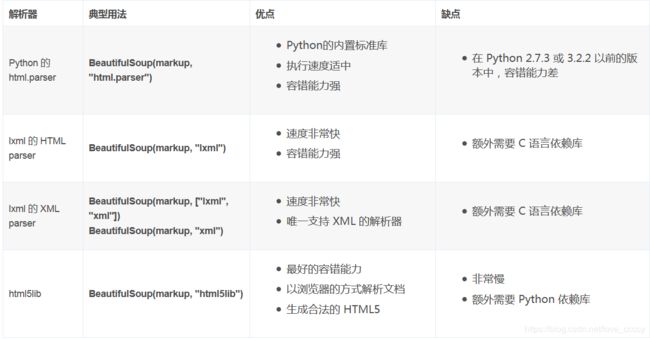BS4文档
BeautifulSoup是一个可以从HTML或XML文件中提取数据的Python库。
它可以通过你喜欢的转换器实现惯用的文档导航、查找、修改等方式。
我们所使用的文档解析函数如下:
from bs4 import BeautifulSoup
BeautifulSoup(
markup='',
features=None,
builder=None,
parse_only=None,
from_encoding=None,
exclude_encodings=None,
**kwargs,
)
- markup: 表示要被解析的标记,一个字符串对象或类似文件的对象。
- features:要使用的解析器的理想特性。
这可能是特定解析器的名称(“lxml”、“lxml-xml”、“html.parser”,or “html5lib””)。
或者它可能是要使用的标记类型(“html”、“html5”、“xml”)。建议您指定一个特定的解析器,以便Beautiful Soup在平台和虚拟环境中提供相同的结果。 - builder: 一个特定的树构建器,用来来使用而不是根据“功能”来查找。你不应该用这个。
- parse_only:一个Soup过滤器。只考虑文件中与Soup过滤器匹配的部分。这在解析文档的某些部分时非常有用,否则这些部分将太大而无法装入内存。
- from_encoding:表示要解析的文档编码的字符串。如果Beautiful Soup错误地猜测了文档的编码,请传递此信息。
- exclude_encodings:指示已知编码错误的字符串列表。
如果您不知道文档的编码,但是知道Beautiful Soup的猜测是错误的,那么请传递这个信息。
将一段字符串或一个文件句柄传入BeautifulSoup的构造方法,就能得到一个BeautifulSoup文档对象(** 复杂的树形结构 **)。这个对象和解析的HTML本身有很多相同的地方,因为BeautifulSoup是将HTML文档转换成一个复杂的树形结构。
对象的种类
树形结构里,每个节点都是Python对象,所有对象可以归纳为4种:
Tag,NavigableString,BeautifulSoup,Comment
Tag-标签
Tag对象与XML或HTML原生文档中的tag相同。
soup=BeautifulSoup(' ')
#获取标签
soup.p
#
Tag有很多属性(遍历文档数和搜索文档树中有详细解释),最重要的属性:name和attributes。
- name
每个tag都有自己的名字,通过 .name 来获取。
name属性通过赋值可改变(会影响BeautifulSoup对象生成的文档)。
soup.p.name
# 'p'
soup.p.name='q'
soup
#
- attributes
一个tag可能有很多属性, 对属性的操作方法与字典相同 ,也可以通过 .attrs 来获取。
tag的属性可以被添加、删除或修改。 - 多值属性
在BeautifulSoup中多值属性的返回类型是list(列表):
soup.q['class']
# ['body','language']
soup.q.attrs
# {'class': ['body', 'language']}
soup.q['id']=1
soup
#
soup.q.get('class')
#['body', 'language']
如果某个属性看起来有多个值,但是任何版本的HTML定义中都没有定义过,那么BeautifulSoup会将这个属性作为字符串输出。
如果转换的是XML格式的文档,那么tag中不包含多值属性。
id_soup=BeautifulSoup('')
id_soup.p.attrs
#{'id': 'my id'}
NavigableString
- 字符串常被包含在tag内,可用 .string 获取tag内的字符串。
- Beautiful Soup用 NavigableString 类来包装tag中的字符串,用type()函数查看,返回值为’bs4.element.NavigableString’。
- tag中的字符串不能编辑,可以被替换,用 replace_with() 方法。
tag.string.replace_with(' ') #tag.string不能为空
- 字符串不支持.contents或.string属性或find()方法。
BeautifulSoup
BeautifulSoup对象表示的是一个文档的大部分内容, 大部分时候,可以把它当做Tag对象,但是它并不是真正的HTML或XML的Tag,所以它没有name和attributes属性,但是BeautifulSoup对象包含了一个值为’[document]'的特殊属性 .name。(BeautifulSoup对象里面的标签tag有.name属性)
Comment
Comment对象是一个特殊类型的NavigableString对象,它是文档的注释部分以及一些特殊字符串。
a=""
soup=BeautifulSoup(a)
comment=soup.b.string
type(comment)
# 'bs4.element.Comment'
下面是《爱丽丝梦游仙境》的一段内容,后面的分析将一直引用该例子:
html_doc = """睡鼠的故事
睡鼠的故事
从前有三位小姐姐,她们的名字是:
埃尔西,
莱斯和
蒂尔莉;
她们住在一个井底下面。
...
"""
遍历文档树
子节点
一个Tag的子节点可以是其他的Tag或者是多个字符串。
BeautifulSoup提供了很多操作和遍历子节点的属性。
注意:字符串没有属性,因为字符串没有子节点。
- .
例如,如要获取< head >标签,用soup.head。
如要获取标签< body >标签中的 < b >标签,用soup.body.b。
注意:通过点取属性的方式,只能获得当前名字的第一个tag。(如果想得到所有标签,用搜索遍历树中的find_all()方法) - .contents
tag的 .contents 属性可以 将tag的子节点以列表的方式输出。(直接子节点) - .children
获取tag的所有 直接子节点(非子孙节点),通过.children生成器,可以对tag的子节点进行循环,遍历所有子节点。 - .descendants
获取tag的所有子孙节点。 - .string
- 如果tag只有一个 NavigableString 类型子节点,那么这个tag可以使用 .string 得到子节点。
- 如果一个tag仅有一个子节点(说明tag没有字符串直接子节点),那么这个tag也可以使用 .string 方法,输出结果与当前唯一子节点的 .string 结果相同。
- 如果tag包含了多个子节点,tag就无法确定 .string 方法应该调用哪个子节点的内容,此时输出结果是None。
- .strings和stripped_strings
如果tag中包含多个字符串 ,可以使用 .strings 来循环获取:
for string in soup.strings:
print(repr(string))
输出的字符串中可能包含了很多空格或空行,使用 .stripped_strings 可以去除多余空白内容:
for string in soup.stripped_strings:
print(repr(string))
父节点
每个tag或字符串都有父节点(基本都包含在某个tag中)。
- .parent
通过 .parent 属性来获取某个元素的父节点。
文档顶层节点,比如爱丽丝文档里面的< html >的父节点是BeautifulSoup对象。
BeautifulSoup 对象的 .parent 是None。 - .parents
通过元素的 .parents 属性可以递归得到元素的所有父辈节点(当前tag到根节点的所有节点)。
兄弟节点
同一层(是同一个元素的子节点)的节点,可以被称为兄弟节点,兄弟节点有相同的缩进级别。
- .next_sibling 和 .previous_sibling
在文档树中,使用 .next_sibling 和 .previous_sibling 属性来查询兄弟节点。
实际文档中的tag的 .next_sibling 和 .previous_sibling 属性通常是字符串或空白. 看看“爱丽丝”文档:
a href="http://example.com/elsie" class="sister" id="link1">Elsie,
a href="http://example.com/lacie" class="sister" id="link2">Lacie and
a href="http://example.com/tillie" class="sister" id="link3">Tillie;
如果以为第一个< a >标签的 .next_sibling 结果是第二个< a >标签,那就错了,真实结果是第一个< a >标签和第二个< a >标签之间的逗号和换行符。(可以自己用 print(soup.prettify()) 输出查看,可以发现’ ,\n’和< a >处于同一层。)
- .next_siblings 和 .previous_siblings
通过 .next_siblings 和 .previous_siblings 属性可以对当前节点的兄弟节点迭代输出。
for sibling in soup.a.next_siblings:
print(repr(sibling))
for sibling in soup.find(id="link3").previous_siblings:
print(repr(sibling))
回退和前进
HTML解析器把这段字符串转换成一连串的事件: “打开< html >标签”,”打开一个< head >标签”,”打开一个< title>标签”,”添加一段字符串”,”关闭< title>标签”,”打开< p>标签”,等等。Beautiful Soup提供了重现解析器初始化过程的方法。
- .next_element 和 .previous_element
.next_element 属性指向解析过程中下一个被解析的对象(字符串或tag),结果可能与 .next_sibling 相同,但通常是不一样的(下一个解析对象很少是下一个兄弟节点,因为节点里面基本都有字符串子节点)。 - .next_elements 和 .previous_elements
通过 .next_elements 和 .previous_elements 的迭代器就可以向前或向后访问文档的解析内容,就好像文档正在被解析一样。
搜索文档树
Beautiful Soup定义了很多搜索方法,这里着重介绍2个: find() 和 find_all() 。其它方法的参数和用法类似。
过滤器
介绍 find_all() 方法前,先介绍一下过滤器的类型 ,这些过滤器贯穿整个搜索的API。过滤器可以被用在tag的name中,节点的属性中,字符串中或他们的混合中。
- 字符串
最简单的过滤器是字符串。在搜索方法中传入一个字符串参数,Beautiful Soup会 查找与字符串完整匹配的内容。
soup.find_all('b')
#[睡鼠的故事]
- 正则表达式
如果传入正则表达式作为参数,Beautiful Soup会 通过正则表达式的 match() 来匹配内容。
match(pattern, string, flags=0)
Try to apply the pattern at the start of the string(一个字符串的开始部分), returning
a Match object, or None if no match was found.
import re
for tag in soup.find_all(re.compile('b')):
print(tag.name)
#body
#b
- 列表
如果传入列表参数,Beautiful Soup会将 与列表中任一元素匹配的内容返回。
soup.find_all(['a','b'])
#[睡鼠的故事,
#埃尔西,
#莱斯,
# 蒂尔莉]
- True
True 可以 匹配任何值。
for tag in soup.find_all(True):
print(tag.name)
#html
#head
#title
#body
#p
#b
#p
#a
#a
#a
#p
方法
如果没有合适过滤器,那么还可以定义一个方法,方法只接受一个元素参数 ,如果这个方法返回 True 表示当前元素匹配并且被找到,如果不是则反回 False。
下面方法校验了当前元素,如果包含 class 属性却不包含 id 属性,那么将返回 True:
def has_class_but_no_id(tag):
return tag.has_attr('class') and not tag.has_attr('id')
将这个方法作为参数传入 find_all() 方法,将得到所有< p >标签:
soup.find_all(has_class_but_no_id)
# [The Dormouse's story
,
# Once upon a time there were...
,
# ...
]
find_all()
find_all(self, name=None, attrs={}, recursive=True, text=None, limit=None, **kwargs)
Extracts a list of Tag objects that match the givencriteria.
find_all() 方法 搜索当前tag的所有tag子节点,并判断是否符合过滤器的条件。
- name参数
name 参数可以查找所有名字为 name 的tag(字符串对象会被自动忽略掉,对象tag里包含的字符串会完整输出)。
搜索 name 参数的值可以是任一类型的 过滤器 (字符串,正则表达式,列表, True)或者方法。 - keyword 参数
如果一个指定名字的参数不是搜索内置的参数名,搜索时会把该参数当作指定名字tag的属性来搜索。
soup.find_all(id='link2')
# [Lacie]
搜索指定名字的属性时可以使用的参数值包括 字符串 , 正则表达式 , 列表, True 。
soup.find_all(href=re.compile("elsie"))
# [Elsie]
- attrs参数
使用多个指定名字的参数可以同时过滤tag的多个属性。
有些tag属性在搜索不能使用,比如HTML5中的 data-* 属性,
data_soup = BeautifulSoup('foo!')
data_soup.find_all(data-foo="value")
# SyntaxError: keyword can't be an expression
但是可以通过 find_all() 方法的 attrs 参数定义一个字典参数来搜索包含特殊属性的tag。
data_soup.find_all(attrs={"data-foo": "value"})
# [foo!]
- text参数
通过 text参数可以搜索文档中的字符串内容。与 name 参数的可选值一样, string 参数接受字符串 , 正则表达式 , 列表, True。
在BeautifulSoup会找到.string方法与text参数值相符的tag,所以text参数可以用string表示。
soup.find_all(string="Elsie")
# ['Elsie']
soup.find_all(text="Elsie")
# ['Elsie']
- limit 参数
find_all() 方法返回全部的搜索结构,如果文档树很大那么搜索会很慢.如果我们不需要全部结果,可以使用 limit 参数限制返回结果的数量。效果与SQL中的limit关键字类似,当搜索到的结果数量达到 limit 的限制时,就停止搜索返回结果。 - recursive 参数
调用tag的 find_all() 方法时,Beautiful Soup会检索当前tag的所有子孙节点,如果只想搜索tag的直接子节点,可以使用参数 recursive=False。 - 按CSS搜索
可以按CSS搜索(按照CSS类名搜索),class类可以通过class_参数搜索有指定CSS类名的tag。
soup.find_all("a", class_="sister")
# [Elsie,
# Lacie,
# Tillie]
class_ 参数同样接受不同类型的 过滤器 ,字符串,正则表达式,方法或 True。
如果tag的class属性是多值属性,按照CSS类名搜索tag时,分别搜索tag中的每个CSS类名,就可以得出搜索全类名的效果(也可以完全匹配,完全匹配时,类名顺序不能乱)。
注意
由于find_all()几乎是BeautifulSoup中最常用的搜索方法,所以我们定义了它的简写方法.。BeautifulSoup 对象和 tag 对象可以被当作一个方法来使用,这个方法的执行结果与调用这个对象的 find_all() 方法相同,下面两行代码是等价的:
soup.find_all("a")
soup("a")
soup.title.find_all(string=True)
soup.title(string=True)
find()
find(self, name=None, attrs={}, recursive=True, text=None, **kwargs)
Return only the first child of this Tag matching the given
criteria.
有时我们只想得到一个结果,可以直接使用find()方法,相当于直接使用find_all方法并设置limit=1参数。
唯一的区别是 find_all() 方法的返回结果是值包含一个元素的列表,而 find() 方法直接返回结果。
find_all() 方法没有找到目标是返回空列表, find() 方法找不到目标时,返回 None。
find_parents() 和 find_parent()
find_parents(self, name=None, attrs={}, limit=None, **kwargs)
Returns the parents of this Tag that match the given
criteria.
find_parent(self, name=None, attrs={}, **kwargs)
Returns the closest parent of this Tag that matches the given
criteria.
记住: find_all() 和 find() 只搜索当前节点的所有子节点,孙子节点等.。
find_parents() 和 find_parent() 用来搜索当前节点的父辈节点,搜索方法与普通tag的搜索方法相同。
find_next_siblings() 合 find_next_sibling()
find_next_sibling(self, name=None, attrs={}, text=None, **kwargs)
Returns the closest sibling to this Tag that matches the
given criteria and appears after this Tag in the document.
find_next_siblings(self, name=None, attrs={}, text=None, limit=None, **kwargs)
Returns the siblings of this Tag that match the given
criteria and appear after this Tag in the document.
find_previous_siblings() 和 find_previous_sibling()
find_previous_siblings(self, name=None, attrs={}, text=None, limit=None, **kwargs)
Returns the siblings of this Tag that match the given
criteria and appear before this Tag in the document.
find_previous_sibling(self, name=None, attrs={}, text=None, **kwargs)
Returns the closest sibling to this Tag that matches the
given criteria and appears before this Tag in the document.
find_all_next() 和 find_next()
find_all_previous() 和 find_previous()
CSS选择器
在Tag 或 BeautifulSoup 对象的 .select() 方法中传入字符串参数, 即可使用CSS选择器的语法找到tag。Beautiful Soup支持大部分的CSS选择器。
- 通过tag标签逐层查找
soup.select("html head title")
# [The Dormouse's story ]
- 找到某个tag标签下的直接子标签
soup.select("head > title")
# [The Dormouse's story ]
- 找到兄弟节点标签
soup.select("#link1 ~ .sister")
# [Lacie,
# Tillie]
soup.select("#link1 + .sister")
# [Lacie]
- 通过CSS的类名查找
- 通过tag的id查找
- 同时用多种CSS选择器查询元素
- 通过是否存在某个属性来查找
- 通过属性的值来查找
修改文档树
- 修改tag的名称和属性
- 修改 .string
给tag的 .string 属性赋值,就相当于用当前的内容替代了原来的内容。
注意: 如果当前的tag包含了其它tag,那么给它的 .string 属性赋值会覆盖掉原有的所有内容包括子tag。 - append()
tag.append() 方法向tag中添加内容,就好像Python的列表的 .append() 方法.
soup = BeautifulSoup("Foo")
soup.a.append("Bar")
soup
# FooBar
soup.a.contents
# ['Foo', 'Bar']
- .new_tag()
创建一个tag最好的方法是调用工厂方法 BeautifulSoup.new_tag()。
soup = BeautifulSoup("")
original_tag = soup.b
new_tag = soup.new_tag("a", href="http://www.example.com")
original_tag.append(new_tag)
original_tag
#
- insert()
把元素插入到指定的位置.与Python列表总的 .insert() 方法的用法下同。
tag.insert(1, "but did not endorse ")
- insert_before() 和 insert_after()
insert_before() 方法在当前tag或文本节点前插入内容。
insert_after() 方法在当前tag或文本节点后插入内容。 - clear()
tag.clear() 方法移除当前tag的内容。 - extract()
PageElement.extract() 方法将当前tag移除文档树,并作为方法结果返回
soup.i.extract()
i_tag.string.extract()
- decompose()
tag.decompose() 方法将当前节点移除文档树并完全销毁。 - replace_with()
PageElement.replace_with() 方法移除文档树中的某段内容,并用新tag或文本节点替代它。 - wrap()
PageElement.wrap() 方法可以对指定的tag元素进行包装 [8] ,并返回包装后的结果。 - unwrap()
tag.unwrap() 方法与 wrap() 方法相反.将移除tag内的所有tag标签,该方法常被用来进行标记的解包。
